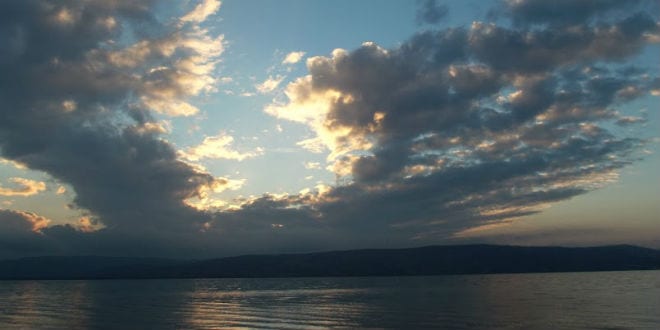In a global first, Israel has begun fully pumping desalinated water from the Mediterranean Sea into the Kinneret, also known as the Sea of Galilee, marking the full-scale launch of a project hailed as a safeguard for the country’s long-term water security.
The initiative, dubbed the “Reverse Carrier,” reverses the direction of Israel’s original National Water Carrier, which for decades transported water from the Kinneret southward. Now, desalinated seawater is traveling the same route in the opposite direction—flowing from coastal desalination plants to replenish Israel’s only freshwater lake.
Tests carried out by scientists indicate that the project will not have any significant deleterious effect on the ecosystem.
The project consists of several east–west arteries that rely on pumping. The new pipelines connect five desalination plants along the coast with the Kinneret via 100-kilometer water channels, advanced quality control and command systems, and water reservoirs.
The project will allow the maximum streaming of 120 million cubic meters of water back into the Kinneret. Today, some 585 million cubic meters of water per year are desalinated in the State of Israel. Upon completion, most drinking water supplied to Israel’s residents will come from desalinated seawater.
Seawater desalination is the most reliable source for enriching the water supply, as seawater is available in unlimited quantities and involves no dependency on climate or political factors.
“This project is of tremendous national importance,” said Israel Water Authority Director General Yechezkel Lifshitz. “The Kinneret is our national reservoir. Historically, it has been a vital source of drinking water, and even today it remains a strategic national reserve.”
Construction on the Reverse Carrier began in 2018, and the system was inaugurated in 2022 at a cost of roughly NIS 900 million ($269 million). After several months of pilot use, full-scale pumping only began this autumn, triggered by the country’s driest winter in a century, which saw the Kinneret approach its critical “red line” minimum level.
The desalinated water—supplied from plants in Ashdod, Hadera, and other coastal cities—is being pumped over distances of 100 to 150 kilometers. It enters the Kinneret through the Zalmon Stream, reviving a previously dry streambed with a continuous year-round flow. During the coming months, up to 5,000 cubic meters of water per hour are expected to reach the lake, totaling tens of millions of cubic meters by the end of winter.
The project consists of several east–west arteries that rely on pumping. The new pipelines connect five desalination plants along the coast with the Kinneret via 100-kilometer water channels, advanced quality control and command systems, and water reservoirs.
Today, some 585 million cubic meters of water per year are desalinated in the State of Israel. Upon completion, most drinking water supplied to Israel’s residents will come from desalinated seawater.
While desalination is not new, what makes the Reverse Carrier unique is the concept of channeling desalinated water back into nature, rather than only using it for urban and agricultural supply. “We view nature not only as a supplier of water but also as a consumer of water,” Lifshitz explained.
Officials emphasize that the desalinated water is of higher quality than the lake’s natural inflows in terms of salinity and purity, and that no adverse environmental impacts are anticipated. Pumping may be reduced or halted temporarily if northern rainfall is extreme.
The Kinneret has long been both a natural treasure and a strategic resource. Its most significant natural inflows come from the Upper Jordan River system, fed by the Hasbani, Dan, and Banias rivers in the Galilee and Golan. But declining rainfall patterns across the region—exacerbated by climate change—have threatened the stability of this supply.
For decades, the Kinneret, Israel’s only freshwater reservoir, was the heart of the National Water Carrier. Water from the Kinneret in the north was carried southward to homes nationwide. Now, the Kinneret acts essentially as a reservoir for emergency water.
“This project was conceived with a long-term perspective,” Lifshitz said. “We anticipate a decline in rainfall across the Middle East, particularly in northern Israel. To preserve the Kinneret as both a natural asset and a strategic reservoir, we must act now. Our master plan already extends to 2075.”
The Sea of Galilee, also known as the Kinneret, is mentioned in the Hebrew Bible and prominently featured in the New Testament.
The Kinneret first appears in the Bible in the Book of Numbers:
From Shepham the boundary shall descend to Riblah on the east side of Ain; from there the boundary shall continue downward and abut on the eastern slopes of the Sea of Chinnereth. Numbers 34:11
Some scholars believe the name comes from a Hebrew word kinar meaning “harp.”
Falling water levels are prophesied to take place at the end of days.
And the waters shall fail from the sea, and the river shall be drained dry, and the rivers shall become foul; the streams of Mitzrayim shall be diminished and dried up; the reeds and flags shall wither. Isaiah 19:5-6
If this does appear, Israel’s role as a leader in desalination will be in demand.
The Zohar, the foundational work of Jewish mysticism compiled by Rabbi Shimon Bar Yochai, a Jewish sage from the second century known by the acronym Rashbi, cites the Galilee as the place in which the beginnings of the Messiah can first be seen.
The Messiah… will arise in the land of Galilee… the Messiah shall reveal himself in the land of Galilee because in this part of the Holy Land the desolation (Babylonian exile) first began, therefore he will manifest himself there first. [Zohar III, Shemoth 7b, 8b, 220a; Otzar Midrashim, 466]
In 2018, Rabbi Dov Kook, a mystic from Israel with a large following, made a startling announcement at a gathering of his followers. In the vision, the Rashbi told Rabbi Kook that the Kinneret filling up is a sure sign that the Messiah’s arrival is imminent.
It can only be hoped that when the Sea of Galilee is full to overflowing and the government opens the floodgates, allowing water to flow down to the Dead Sea, this could bring about Ezekiel’s vision of the Dead Sea as a post-Messiah source of life.
All kinds of trees for food will grow up on both banks of the stream. Their leaves will not wither nor their fruit fail; they will yield new fruit every month, because the water for them flows from the Temple. Their fruit will serve for food and their leaves for healing.” Ezekiel 47:12





